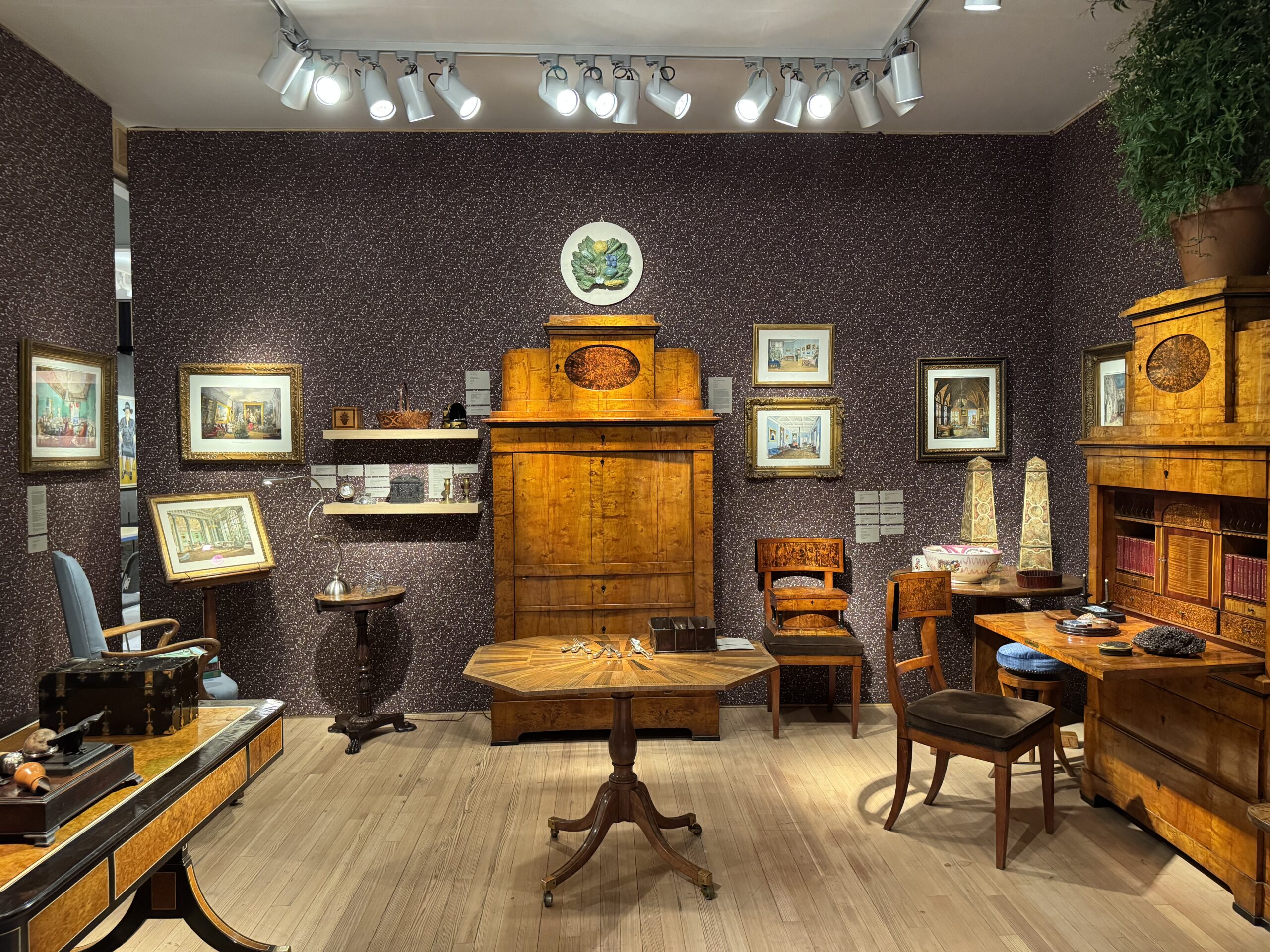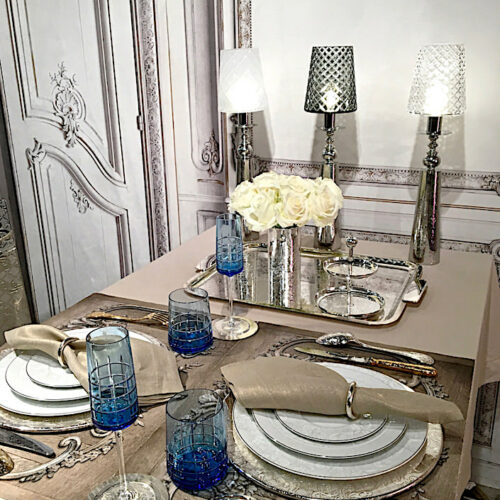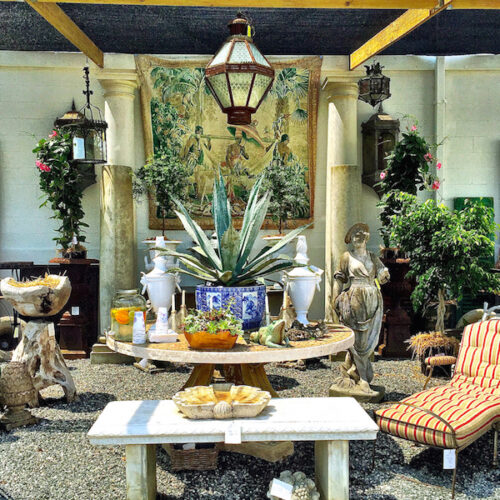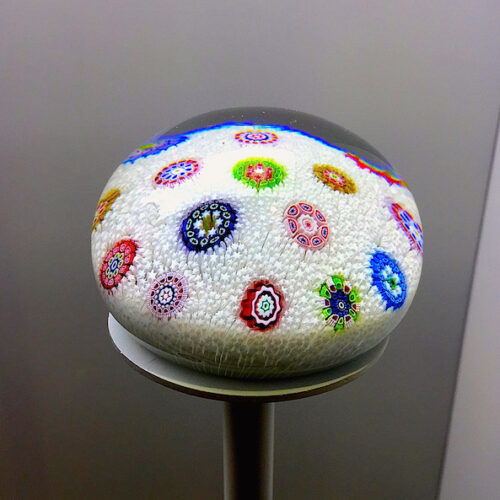Always one of the early highlights of the arts season in New York, The Winter Show opened last night at the Park Avenue Armory with an abundance of showstopping collections. With over 70 exhibitors, the show includes an impressive range of exceptional art, design and antiques from around the world, all benefitting the East Side House Settlement. One of the strongest aspects of the carefully vetted show is its vast variety of museum quality objects and fine art from renowned international dealers that spans over 5,000 years.

Cove Landing always presents a selection of covetable furniture and art that this year was set against an enveloping backdrop of Swedish wallpaper that set off two handsome Biedermeier companion pieces admirably. With similar frontal facades when closed, opened they reveal that one is actually a writing desk and the other an armoire. A rare and clever neoclassical pair!

A more decorative offering is the enchanting Wittgenstein Family Album, a set of twenty-five interior watercolors documenting the prominent family’s residences in Russia, Germany, Italy and France in the early 19th century. “Vividly depicting largely unpeopled rooms, the album is a brid’s eye view into a way of life and an unspoken pride of possession.” Above a Winter Garden in The Columned Salon at Ivanovski.
The Album was featured in an exhibition at the Frick in 1992 and in An Album of Nineteenth-Century Interiors by Charlotte Gere, as Angus Wilkie shows above.

Other favorites include a pair of 19th century Italian tole obelisks, above, and a mid-19th century English ebonized and brass tea caddy with fitted interior, below.


The distinguished American antiques dealer Levy Galleries collaborated on their booth with designer Ralph Harvard, whose installations I always admire.

Ralph created a ‘Chinese Parlor’ with a beautiful de Gournay silk wall covering for the gallery’s display of primarily Chippendale furniture, art and portraiture. With a singular knowledge of 18th century design, he offers some back story. “‘Chinese’ wallcoverings were imported from China to Britain beginning in the late 17th century. Most of the great houses of Europe had at least one room decorated with a Chinese paper, original or imitation. By the end of the 18th century they were to be found in most modest sized houses too. Intact examples in America are rare, but many sets survive from the first half of the twentieth century. From 1910-1930, the Colonial Revival movement was ascendant in America, with about 40% of U.S. homes built in the Colonial Revival style. Major collectors and museums all wanted a “Chinese Parlor,” maybe inspired by Henry Sleeper at Beauport, or FH Dupont at Winterthur. The Metropolitan Museum, the Philadelphia Museum, and the Governor’s Palace in Williamsburg set the stage, followed heavily in the South at houses like the Givves and Rose Houses in Charleston and too many Bottomeley and Atlanta houses to mention. From the Colonial Dames Headquarters to the White House, the favored rooms boasted “antique” Chinese paper. Since the Levy Galleries are the premier Americana dealers at the Winter Show, we thought it would be appropriate to have a ‘Chinese Parlor’ as a backdrop. … The main entrance (above) is through an Eastern inspired portal (though the porfiles are of my daughter, Holland).”

Dutch still lifes are perennial favorites. Richard Green Gallery is showing several late 18th century examples from Pieter Faes.


and Lawrence Steigrad Fine Arts is offering this monumental (64.57″ tall) oil by Jacobus Vonk from 1773.

Suzanne Belperron (read more about her here) pieces are always on my radar and Véronique Bamps has two beauties – stunning cushion cut and cabochon earrings

and a graceful chalcedony and diamond star fish brooch.

Milord Antiques from Montreal presented a beautiful eclectic booth grounded with an evocative Fromental wall covering.

Periods and styles mixed effortlessly in the entrance, below, with several cleverly placed Line Vautrin mirrors above a rare LaVerne Chan Li enamel cabinet.

The father and son artist team of Philip and Kelvin LaVerne (find a monograph of their work here) produced a unique array of unusual and widely collected works often with historical references. Milord is also showing a rare Chi-Liang coffee table

in patinated bronze and pewter with incredible details depicting the Gods of Heaven and Earth united by the River of Life.

Ceramics are a passion and the Art Deco porcelain vase Pierre-Auguste Gaucher created for Sevres is stunning, practically glowing with a hunting scene in green and gold enamel.

My favorite new exhibitor is São Roque Antiques from Lisbon featuring primarily 16th – 18th century Portuguese furniture, ceramics, silver and fine art.

Their presentation of 17th century Portuguese faience is sublime. As art historian José Meco explains, “Faience produced in Lisbon during the seventeenth century can be considered one of the most original and creative decorative manifestations of Portuguese art.”

The undeniable charm of a Portuguese faience chimera aquamanile from 1620-1640 below.

Silver represents another field of excellence in the realm of Portuguese decorative arts and João Coelho de Sampaio was a master who created exceptional objects such as the splendid King José I silver teapot, below, with its elegant swan neck spout and exquisite engraving.

Simon Teakle is always a destination for distinctive jewelry. The large c. 1830 English antique diamond spray brooch below is a beauty, designed as a series of palmette motifs with the center circular cluster set en tremblant.

And I couldn’t resist taking this antique agate riviera necklace for a spin – English circa 1810 and SO my colors!!

Clinton Howell is showing a pair of impressive (12″ tall) presentation fire buckets c. 1800, gilded leather with silverplate that serve a number of decorative purposes.

And this ebony presentation box with silver and semi-precious stones is a charmer.

Four Spanish Colonial (likely from Mexico) paintings comprising Allegories of the Four Continents are a marvelous example of cross cultural exchange in art across continents. As Robert Simon Fine Art explained, “The art of the Spanish Americas is predominantly religious in subject. These four paintings are outstanding exceptions to the norm.” Each depicts one of the four continents known in the 18th century, as imagined based on European print sources. Such a cross cultural depiction without primary account witness led to such creative, and in this case rather fanciful, renderings.


At A la Vielille Russie, an equally whimsical creation caught my eye in the form of a fabulous pavé diamond dagger brooch with red coral and cabochon turquoise scabbard….

with a surprise! The dagger retracts to form two separate pins.

Any fan of bird illustration knows of Audubon but John Gould is also heralded in the annals of such works and Peter Harrington is presenting a magnificent set of the celebrated Gould folios. Each of the oversized 43 volumes is bound in full morocco and filled with the most exceptional depictions of exotic birds.

As the rare book dealer explains, “The oft-reproduced illustrations of birds are among the finest ever executed. Published across six decades, the folios are seldom gathered together and presented in uniform bindings, and as such rarely come to market.”

As always, Maison Gerard presented a booth filled with unique selections of antique and contemporary art. Their entry featured an imposing illuminated wall-mounted stoneware sculpture by Guy Bareff

with amazing depth and texture.

I have alway adored the work of artist Miriam Ellner and her ethereal eglomisé panel painting River Blossom did not disappoint.

“This Verre Eglomisé Japanese-inspired cherry blossom tree sitting alongside a stylized river foretells the awakening of spring renewal and new beginnings.The pink petals and falling blossoms have an ephemeral beauty that is short lived, for they fall into, and are carried away by, the constantly running.”

Art is often a fluid affair and many artists sought to migrate from fine art to other mediums. Nowhere is this truer than at Didier Ltd where the focus is jewelry designed by 20th century masters.

The Dali earrings above are based on his famous painting The Enigma of Hitler. As you may know, Dali’s preoccupation and perceived sympathetic opinion of Hitler was the cause of his expulsion from the Surrealists. The telephones represent the first WWII truce between nations which British Prime Minister Neville Chamberlain conducted via phone. But Hitler invaded Poland anyway and the embarrassment led to the election of Churchill as new Prime Minister. The painting was Dali’s expression of this dark moment in history as are the earrings, with the rubies and emeralds representing tears.

The nature inspired work of Claude Lalanne translates beautifully to jewelry as in the Dahlia necklace above. And Louise Nevelson’s monolithic monochromatic wooden sculptures are expressed in miniature form in the wood and gold necklace below.

Although known for his paintings, sculpture and mobiles, Alexander Calder actually created more than 1,800 pieces of jewelry, worn by patrons and artists such as Peggy Guggenheim and Georgia O’Keefe so I felt in very good company when I sported his tiara. Designed for Rose Masson, wife of the French artist André Masson, it is from a single piece of undulating silver with festive articulated circles.
The show also marked the return of the special exhibition FOCUS: Americana, celebrating Americana design history and showcasing a selection of exceptional early American fine art, folk art, and antiques curated by Alexandra Kirtley, the Montgomery-Garvan Curator of American Decorative Arts at the Philadelphia Museum of Art. A couple favorites include The Great Seal of the United States from 1875, exhibited by Allan Katz Americana

and the charming depiction of the Brigantine Adelaide by Parley Scott Downer, c. 1891. Executed in crayon, colored pencil and ink on paper with a period painted frame, it is shown by David A. Schorsch – Eileen M. Smiles Fine Americana.

I always love Carolle Thibaut-Pomerantz’s booth again this year in collaboration with Galerie Léage.

Loving the scenic antique wallpaper panels of course and that Louis XV armchair upholstered in what looks like a Prelle velvet.

Ronald Phillips present The St. Giles’s House Suite, c. 1765 – a pair of George III mahogany settees and a pair of George III mahogany library armchairs attributed to the renowned English cabinetmaker William Vile.


And this glamorous pair of Irish George III cut mirror chandeliers would make anyone look better by their shimmering light.

Walking the show itself is an education but the event also includes a bevy of sure-to-be fascinating panel discussions and the celebrated Young Collectors Night, fostering the next generation of collectors, and art and design aficionados. Open through February 2 the show is a not to be missed venue to collect, learn and view a history of exceptional talent and craftsmanship through the ages. Hours and more here.
all photos by Stacey Bewkes for Quintessence







You’re always so informative! I love seeing this show through your eyes.
Thank you Kim!
Thank you! Wonderful!
Thank you – so glad you enjoyed.
The necklace looks fabulous and so do you!
Thank you Linda! 😉
I love seeing the show through your eyes. The show has a special air and creates a spell of excitement and discovery. Thank you for sharing it.
It does indeed and my pleasure – thank you for stopping by!
Quite an amazing show. Thank you for the wonderful tour & comments. Love the necklace.
It really is! My pleasure and I love the necklace too! Thank you Kris!
Lovely to see this ! Carolle is an old friend ! ( I took her years ago to tour 19th c wall papers in Riofrio palace nearby Segovia ). And I bought one of my nicest tapestries from Saõ Roque ! Warmest regards ,Mercedes .
Thank you for stopping by Mercedes! What a small world. I always love Carolle’s booth and was delighted to discover Saõ Roque – what treasures!
Thank you for sharing this fabulous exhibit. I loved seeing all the various antiquities.
My pleasure! It’s a great show!
Wow, this looks absolutely incredible! 😍 I had no idea The Winter Show covered so much—from Portuguese faience to Suzanne Belperron jewelry to mid-century LaVerne furniture. It’s like walking through a living museum, but you can actually buy the pieces! That Wittgenstein Family Album sounds especially fascinating… I love when art gives us a glimpse into daily life from another time. And that retractable dagger brooch? Total showstopper. Definitely adding this to my 2025 must-visit list. Thanks for the detailed peek into the event!
I have been following Quintessence for years, but I don’t always remember to view the blog. I viewed along on YouTube; anyhow, I received the newsletter today, at times sporadically, and I viewed this newsletter from days old. It is a lovely feel to it and most enjoyable. Thank you.
Thanks so much!!